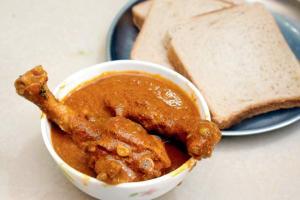The East Indian community stores and sells its bottle masala in dark-complexioned beer bottles. And, it isnu00c3u0083u00c2u00a2u00c3u0082u00c2u0080u00c3u0082u00c2u0099t because they have one too many lying at home

Veronica Rodrigues made the chicken curry from bottle masala. Pic by Ashish Raje
There was a time in Ranwar village, Bandra, when summertime meant drummers at every corner. The air would be filled with the beats of pestle hitting mortar, and women pounding whole spices into dust. These ingredients would then come together to make bottle masala, every East Indian family's family secret.
The make-up of the bottle masala will always remain closely-guarded because its making isn't everyone's cup of tea. Depending on the recipe you follow, the number of spices ranges from 26-36. The spices are sun-dried for a few days (the chillies should have a crisp, crackling sound), individually roasted, pounded into submission, folded together and stored in beer bottles. Thankfully, a few members from the East Indian community, undaunted by the process, do it every summer.
ADVERTISEMENT

Veronica Rodrigues and her bottle masala. Pic/Ashish Raje
Mister of spices
With a silver-coloured ponytail and a Rajasthani moustache, Joel Gonsalves, 60, has been making the masala for nearly 30 years. A geotechnical engineer by profession, he does it because "it's a passion. This is part of my ancestral [heritage]. The ingredients and quantities were handed down to us." He learnt the recipe at his mother's knee, and perfected it at his mother-in-law's.
"I came here after marriage, ghar-jamai you call it," he says of his current abode. "I've compiled what I've seen and made my own composition." Under the name of Goma's Spices, Gonsalves retails mostly to family and friends. He's expanded the repertoire to include several masala preparations (for fish, for vindaloo, etc) and a range of powders (haldi, nutmeg, etc). But, bottle masala is what sells like hot cakes. "In masala, they use a term call 'pily.' One pily is 24 beer bottles and about eight kilos of chilli. I make three to four pilies, say about 100 beer bottles, a year."

His version includes 26 ingredients. "I buy the ingredients myself, not by phone or anything. I check the quality myself. For the main spices, such as dalchini, elaichi, jaifal, jaipatri, khus-khus and tejpatta, I go to Kumily, in Kerala. For the other spices I go to the APMC in Vashi. In summertime, the ladies come to pound. So, in February-March, I contact people and ask their requirements." He sells a full beer bottle, a pint and a whisky quarter. (The bottles are recycled Kingfishers, Biras and tharras.) "In the earlier days, it used to be whisky bottles. So, that's how the term 'bottle masala' came. But, you need dark ones so that the light doesn't [enter] and the colour doesn't fade." After the masalas are ready, he plugs a wooden cork in the bottle, and dips it into red sealing wax.
The women who come to pound have an interesting backstory as well. "The [women] have a gang. The older one expires; and the next one takes over. If you patronise one gang, the other will not come to your house. One or two main people stay in Vakola; the rest come during pounding time from the Konkan.

A few of the spices that go into the making of Goma's bottle masala
[I need] four women for pounding, and one for roasting and sieving. One pily will take them two days." Gonsalves instructs them and learns from them at the same time. "I keep my ear [open] to everybody. They said, 'Make the coriander less.' So, I lessened it and it's really working. Normally, [making masalas is] a ladies' job, but my wife has expired, my mother-in-law has expired, my mother has expired. I take it up as a responsibility and I am doing it."
In the spice trade
From her Kurla house, 74-year-old Gertrude D'abreo has been making bottle masala for 40 years. "This year, I made 27 kilos," she says. Her version has 32 ingredients. "It goes abroad mostly. I have local customers also, but it [mostly] goes to Canada, Australia and Germany." She buys her ingredients from Masjid area, and says, "Every ingredient is important. Suppose you're making a curry, you can't minus one ingredient. Your curry will go flop. I put a few things [ingredients] little extra so that the masala becomes tasty. I want people to say that I want hers only."

Gertrude D'Abreo
Another Kurla resident, 58-year-old Veronica Rodrigues, who has been making the masala for 30 years, includes 36 ingredients. She gives them to the chakki for pounding, and makes about 20 kilos a year, mostly for "my daughter-in-law, cousins, aunties, my friends' circle. I give 1-2 kg per person." Rodrigues uses the masala almost every day in her cooking, and had prepared chicken curry for us when we visited. Apart from the chicken and 2 tbsp of the masala, she added wet coconut, onion, garlic, ginger and coriander. The chicken took to the gravy like a duck to water. It was first-rate, homemade food, which made us understand why home-cooked food always has the same comforting flavour. In the East Indian community, the reason is the bottle masala.
To order bottle masala from Gertrude D'abreo, call 9867358560, and to order from Veronica Rodrigues, call 9987893598.
Catch up on all the latest Mumbai news, crime news, current affairs, and also a complete guide on Mumbai from food to things to do and events across the city here. Also download the new mid-day Android and iOS apps to get latest updates
 Subscribe today by clicking the link and stay updated with the latest news!" Click here!
Subscribe today by clicking the link and stay updated with the latest news!" Click here!







